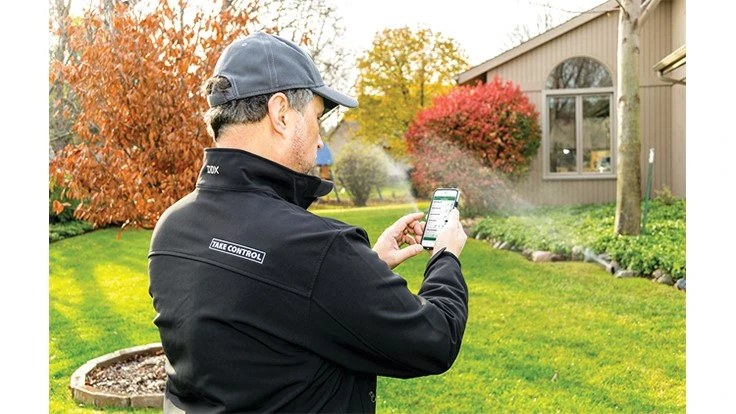
The increased adoption of Wi-Fi-enabled irrigation controllers is prompting contractors to sell their clients on their unique features to gain an edge on the competition, irrigation system manufacturers say.
New developments.
“What tends to be the newest and most common with what we are seeing are integrations with Google and Amazon and other companies that offer home automation,” says Joe Porrazzo, product manager at Rain Bird Corporation.
Smart controller used to mean the controller was adjustable based on weather conditions, he says.
“I think that definition of ‘smart’ has adapted more of the homeowner definition of connectivity. A weather-based programming aspect is assumed in the connection,” Porrazzo says. “Today we are seeing basically every manufacturer offer that type of (Wi-Fi-enabled) product.”
What’s next on the horizon includes more advanced and accurate weather programming – such as for the specific weather conditions at a physical address – micro climates, he says.
“Another trend we are starting to see is flow sensing is becoming a very popular topic for commercial and residential,” Porrazzo says. “I think that is going to get more affordable and easier to use so that a homeowner will be more enticed to use it and monitor their property.”
ETwater controllers (recently acquired by Jain Irrigation) have a feature called predictive analytics.
“Predictive analytics for weather allows us to look forward as well as backward. And that is the latest, greatest that’s happening, I think, in smart controllers, says Richard Restuccia, vice president of water management solutions at Jain Irrigation.
Two-way programmability is also picking up in popularity, says Peter Lackner, product manager for The Toro Company.
“One-way programmability meant your cell phone or your computer could double as a remote control where you’re just turning the sprinkler manually on or off,” he says. “But with two-way programmability you’re now able to fully program the controller from a computer or a cellphone as if you were standing at the controller.”

Popularity contest.
For a long time, advancements with irrigation controllers were spurred by the needs of contractors. Today, homeowners’ needs play a stronger role, Porrazzo says.
“Homeowners are getting much more knowledgeable and are starting to dictate what products are being put in the home or in the ground,” he says. “Every homeowner wants to have Alexa tell their sprinkler to turn on.”
For contractors working with large clients, such as a homeowner’s association with a system controlling 40 zones, easy setup is vital, Restuccia says.
“What’s really important (in a controller) is to have the ability to set one of these zones up and then copy them for the rest of the properties, or the rest of the zones,” he says. “If you make an error on the programming, you’re not going to get the performance you expect.”
In that same scenario, the client, such as the HOA property manager, is likely going to demand readily available reports on the system’s performance, Restuccia adds.
“(They) want to able to share the analytics with my homeowner association boards and be able to easily show them why they use more water or why they use less water,” he says.
Another increasingly popular feature is the capability for an irrigation smart controller to control other features on a property like outdoor lighting.
“We like to think of it as controlling your whole yard, not just your sprinklers now,” he says.
Market variations.
“The adoption rate for different features in different states are different,” Porrazzo says. “California is one of the largest, if not the largest, markets for irrigation in the world. We have to design our products to meet those strong (water conservation) standards.”
Contractors in Texas, Colorado and Florida are feeling a similar push. States without as strict guidelines for water usage are following suit slowly, he says.
Lackner says the request for connectivity in smart controllers is universally demanded. The demand initially came through the commercial space, which is where a lot of innovations are born, but residential clients have followed suit, he adds.
“It has been kind of cost prohibitive for smaller, single home owners, but that’s kind of the next step in smart control,” he says.
“We like to think of it as controlling your whole yard, not just your sprinklers now.” Peter Lackner, product manager, The Toro Company
Project demands.
“The residential customer is more interested in something that is simple and intuitive,” Porrazzo says. “Commercial properties, on the other hand, want that granular control, controllers that can operate multiple valves at a time, that have advanced flow sensing capabilities, very accurate weather sensors and stations.”
It may sound simple, but it’s also important to ensure the controller, if Wi-Fi-enabled, can access Wi-Fi, Restuccia says.
“I always caution people to be sure that where they’re placing their controller, they actually get Wi-Fi. I know, for instance, at my house, if I put my controller in my garage, I don’t get Wi-Fi in my garage. That’s something they should take into account,” he says.
Marketing tips.
There are a few angles contractors can consider when marketing irrigation smart controllers to their clients and to stay out of the lowest bidder game, manufacturers say.
“(Contractors should) market themselves as water management specialists if they are,” Restuccia says. “And I think the way they prove it is with good case studies.”
For example, if the installation of a smart controller saved a client money or conserved a certain amount of water, a case study can help explain the benefit of the controller to a client, Restuccia says.
Another consideration is to create and add opportunities for reoccurring revenue from existing customers, Porrazzo says.
“Connected controllers allow contractors to oversee multiple properties from a tablet or computer. Being able to turn these systems on or off (and monitor the system) is a service they could sell monthly similar to a security system,” he says.
Unique features that not all devices offer are another selling proposition, Lackner says.
“For our products specifically, we actually use proprietary radio technology that gets us three times the range that Wi-Fi gets us,” he says. “We like to use that as an upsell over just a traditional Wi-Fi controller.”

Explore the January 2019 Issue
Check out more from this issue and find your next story to read.




